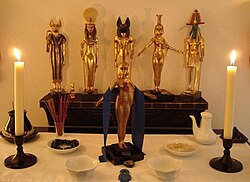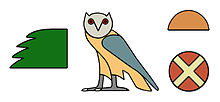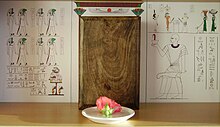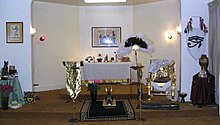Kemetism

| Part of a series on |
| Ancient Egyptian religion |
|---|
 |
|
|
Kemetism (also Kemeticism; sometimes referred to as Neterism from netjer "god"), or Kemetic paganism, is a neopagan religion and revival of the ancient Egyptian religion, emerging during the 1970s. A Kemetic or Kemetic pagan is one who follows Kemetism.[1]
There are several main groups, each of which takes a different approach to its beliefs, ranging from eclectic to reconstructionist. These can be divided intro three types: reconstructed Kemetism, a syncretic approach, and the more monotheistic Kemetic Orthodoxy.[2]
Etymology

The movement's name is based on an endonym of Egypt,[3][4] Kemet (the conventional vocalization of hieroglyphic notation km.t). The word is also sometimes written as Takemet, from the fuller tꜣ km.t.[5] In translation from Egyptian, it means "black" (or in longer form "black land"), which is derived from the black colour of the fertile mud brought by the Nile during the annual floods (currently no longer occurring due to the existence of the Aswan Dam).
Kemetics refer to the ancient Egyptian deities as the Netjeru, also referred to as the Neteru or the Netjer.[6] Kemetics may prefer to refer to the Netjeru with their ancient Egyptian name: for example, they would refer to Horus as Heru, Thoth as Djehuty, and Anubis as Anpu.
Reconstruction


Kemetics do not consider themselves direct descendants of the ancient Egyptian religion but consistently speak of its recreation or restoration.[7][8] Some Kemetics or hermeticists claim direct continuity with secret societies allegedly continuously existing since the prohibition of Paganism by Roman emperor Theodosius I in 392 CE, or since the closing of the last functional Egyptian temple (of the goddess Isis on the island of Philae) by Emperor Justinian around 535.[9][10] However, these claims are historically unprovable.[11]
Since the Hellenistic period, ancient Egyptian religion has influenced many belief systems.[12] For example, Hermeticism is based on the teachings of Hermes Trismegistus (a combination of the Greek god Hermes and the Egyptian god Thoth). Early and medieval Christianity also incorporated ancient Egyptian thought, including in extra-biblical legends of the stay of Jesus in Egypt, the recognition of the authority of Hermes Trismegistos by the Church Fathers and Medieval philosophers, or the adaptation of myths associated with the goddess Isis.[13][14] These mythologies usually interpret ancient Egyptian culture, religion, and gods symbolically.[15] In contrast, the goal of Kemetic groups is a more or less rigorous restoration of the religious system in its historical form, although Kemetists generally admit that a completely accurate imitation of ancient practices is not always possible or even advisable.[16]
Ancient Egyptian religion underwent complex transformations across time and was worshipped differently in different locations.[17][18] One god could have different mythological associations and forms of worship in individual nomes or even individual temples. It is difficult to seek a purely original form of Egyptian religion that can be easily pointed to and reconstructed (see Reconstructionism).
Later reinterpretations of Egyptian religious ideas fundamentally transformed them.[19][20] For example, some question whether the gods should be strictly worshipped by their Egyptian names or whether they can also be addressed by the Greek versions.[21] This question holds special significance for Kemetics due to the ancient Egyptian idea of the importance of name to existence. It has been questioned whether Hellenestic and Christian reimaginings should be included in Kemetic reconstruction, or whether they should instead be excluded as traditions of antiquity.[22] The answer to this question is one of the fundamental differences between various Kemetic groups.
Principles of Kemetism
The idea of god/gods
Different interpretations of the ancient Egyptian religion have different understandings of the monotheistic or polytheistic Egyptian pantheon. The ancient Egyptian religion was a polytheistic religion and Kemetists do not deny this polytheism, but different practitioners may elevate one deity to different levels. In traditionalist practice, each deity is their own individual being, although one may be more powerful.[24] Others may practice henotheism, where practitioners revere many gods but chose to worship one, as manifested, for example, in the cults of Serapis and Isis. In monolatry, practitioners acknowledge many gods but only revere and worship one. Still others may conceptualize the Egyptian pantheon as a single universal divine force manifesting itself in various forms.
Regardless of whether the sun is worshipped as a god by a particular Kemetist or not, as in Ancient Egypt[25][26] the sun is considered to be an image of divine power and the source of every existence. The sun is deified as Ra or, during the New Kingdom, Amun-Ra.
Order

Another important principle of Kemeticism is maat, order. This concept was one of the cornerstones of religious thought of the Ancient Egyptians – its observance was supposed to ensure the stability of the world and its orderly running. Its importance is evident from the fact that even the pharaoh, who was understood as a divine being, was primarily tasked with bearing responsibility for and contributing to maat. The epitome of the concept in Ancient Egyptian religion was the eponymous goddess Maat and her symbol the ostrich feather.
As a result, the respect of rules of all kinds by each individual was synonymous with support and maintenance of the cosmic order, while their non-observance could lead to its disruption. The collapse of maat would lead to the demise of the world and the victory of chaos. In pursuit of maat, Kemetic practitioners may follow prevailing ethical ideas and good manners. However, there is no explicitly binding text codifying moral norms.
Religious practice


Ancient Egyptian practice venerated maat, a concept encompassing truth and honor. Ritual worship of the gods in pursuit of maat is thus considered holy. Commonly worshipped Old Egyptian gods include Ra, Amun, Isis and Osiris, Thoth, Sekhmet, Bastet, Hathor, and others.
This worship generally takes the form of prayer, offerings, and setting up altars.[27] Altars are most often constructed using a statue or two-dimensional representation of one or more given deities, as they serve as the focal point of worship.[28] Most commonly, Kemetism understands the representation symbolically, understanding it as a means to better focus on the divine power.[29][30] A smaller subset of Kemetists may understand the idol as a real representation of the divine being in the human world. Therefore, in accordance with ancient Egyptian tradition, the idol is stored in a special sacred container (nau) from which it is to be removed only in the course of a religious ritual,[citation needed] of which the presentation of sacrifices is the most essential part.
Additional altar items include candles, votive offerings, prayer beads, incense burners, and one or more dishes for food offerings.[31] Most Kemetic offerings try to keep to tradition, offering the same or similar items the ancient Egyptians would have offered.
It is common during worship for Kemetics to pray in the dua (𓀃) gesture, which models the hieroglyph meaning worship and adoration.[32][33]
Kemetic organizations
Kemetic Orthodoxy

The American Society of Kemetic Orthodoxy was founded in the 1980s. It brings together members from various states and, according to its own characterization, attempts to follow the Egyptian traditions as closely as possible and to revive them.[34]
Entirely in this spirit, it is headed by an authority (currently Tamara Siuda) using some of the titles and other attributes of ancient pharaohs. She is conceived as the present incarnation of the royal ka, gold embedded in the spirit of Hora, an aspect of divinity embodied in the human form of a spiritual leader of the community.[34]
On the other hand, it is in this movement that the departure from the traditionalist (i.e., closest to Egyptian religion) conception of god/gods, expressed in the concept of monolatry as official doctrine, is most pronounced.[4]
Fellowship of Isis
Another type of Kemetic organization is the Fellowship of Isis, formed in Ireland. It differs from most others in that, following the model of late antiquity in the henotheistic sense, it focuses on the cult of the goddess Isis, transposed into ancient Greek and Roman settings. Egyptian traditions are therefore heavily modified in him by their ancient interpretation, by religious syncretism, and by modern multiculturalism.[35]
Other Kemetist societies include The Living Nuhati, and the defunct French Ta Noutri.[36]
Kemetism in the Czech Republic
In the Czech Republic there is only one known society claiming to be a member of the Kemetism, the civic association Per Djoser Achet registered by the Ministry of the Interior.[37]
See also
- Egyptian mythology
- List of Neopagan movements
- List of religions and spiritual traditions
- Hermeticism
- Temple of Set – an unrelated religion, centered around the Egyptian god Set
- Ausar Auset Society - Pan-Africanist society centered around Kemetism
Notes
- ^ Daugherty, Michelle (2 October 2014). "Kemetism. Ancient Religions in our Modern World". Michigan State University. USA. Archived from the original on 28 February 2018. Retrieved 18 January 2017.
- ^ Harrison, PM (2012). Profane Egyptologists: The Revival and Reconstruction of Ancient Egyptian Religion. UCL (University College London).
- ^ "Khémitisme, Tradition païenne égyptienne, la religion des anciens égyptiens" (in French). Archived from the original on 2008-12-19. Retrieved 2008-08-21.
- ^ a b "What is Kemetic Orthodoxy? Introduction". Archived from the original on 2008-09-11. Retrieved 2008-08-19.
- ^ Verner, Miroslav; Bareš, Ladislav; Vachala, Břetislav (2007). Encyclopedia of Ancient Egypt. Prague: Libri. p. 168. ISBN 978-80-7277-306-0.
- ^ "Netjer | Kemet.org". www.kemet.org. Retrieved 2023-03-25.
- ^ "International Network of Kemetics". Archived from the original on 2008-10-05. Retrieved 2008-08-21.
- ^ Raneb, Djehutijdjedef. "Egypt - the image of heaven" (in Czech). Retrieved 2009-09-26.
- ^ David(ova), Rosalie (2006). Religion and Magic of Ancient Egypt. Translated by Vymazalová, Hana. Prague: BB/art. p. 333. ISBN 80-7341-698-0.
- ^ Verner, Bareš, Vachala, p. 139
- ^ DeTraci Regula (2002). Isis and her mysteries: understanding the universal goddess. Translated by Muková, Ivana. Prague: Book Club. p. 35. ISBN 80-242-0806-7.
- ^ Hornung, Erik (2002). Mysterious Egypt: the roots of Hermetic wisdom. Translated by Plzák, Allan. Prague: Paseka. pp. 9n, 175n. ISBN 80-7185-436-0.
- ^ Forman, Werner; Quirke, Stephen (1996). Afterlife on the Nile. Translated by Bareš, Ladislav. London: Opus Publishing. pp. 17, 177n.
- ^ Hornung, p. 74n
- ^ see, e.g., Kefer, John (1991). Synthetic Magic. Prague: Trigon. pp. 136n. ISBN 80-85320-18-5.
- ^ Naydler, Jeremy (1999). Temple of the Cosmos: the Ancient Egyptian Experience of the Sacred. Translated by Krůta, Miroslav. Prague: Volvox Globator. pp. 8n. ISBN 80-7207-245-5.
- ^ David(ova), Rosalie (2006). Religion and Magic of Ancient Egypt. Translated by Vymazalová, Hana. Prague: BB/art. p. 68. ISBN 80-7341-698-0.
- ^ Assmann, Jan (2002). Egypt: theology and piety of an early civilization. Translated by Krumphanzlová, Barbora; Bareš, Ladislav. Prague: Oikuméné. ISBN 80-7298-052-1.
- ^ Janák, Jiří (2005). Gate of Heaven: Gods and Demons of Ancient Egypt. Prague: Libri. p. 57. ISBN 80-7277-235-X.
- ^ Hornung, p. 24
- ^ Sannion. "What's in a name?". Archived from the original on 2007-12-06. Retrieved 2009-06-15.
- ^ Raneb Jehutijjedef. "A few little tips before you decide to address the gods" (in Czech). Retrieved September 26, 2009.
- ^ "papyrus | British Museum". www.britishmuseum.org. Retrieved 2024-04-07.
- ^ Raneb Jehutijdjedef. "Cult – the way to the gods" (in Czech). Retrieved 2009-09-26.
- ^ The adoption of the sun as a central divine principle was continuously present in Egyptian religion and remained a subject of constant evolution throughout the Pharaonic period, described many times in literature. Mircea Eliade, for example, refers to it, albeit not with entirely convincing arguments, from a general religious studies point of view as the relationship between theology and the politics of solarization. See Eliade, Mircea (1995). "History of Religious Thought 1: From the Stone Age to the Eleusinian Mysteries". Translated by Dejmalová, Kateřina. Prague: ISE: 106n. ISBN 80-7298-052-1.
{{cite journal}}: Cite journal requires|journal=(help) - ^ The development is summarized in Assmann, Jan (2002). Egypt: theology and piety of early civilization. Translated by Krumphanzlová, Barbora; Bareš, Ladislav. Prague: Oikuméné. p. 61. ISBN 80-7298-052-1.
- ^ "Kemetic Starter Guide". The Twisted Rope. 2011-11-08. Retrieved 2018-12-12.
- ^ DeTraci Regula (2002). "Isis and her mysteries: the knowledge of a universal goddess". Translated by Muková, Ivana. Prague: Book Club: 17. ISBN 80-242-0806-7.
{{cite journal}}: Cite journal requires|journal=(help) - ^ Dutton, Erik. "In Praise of Idols". Archived from the original on 2009-10-17. Retrieved 2009-06-15.
- ^ Kallistos. "On Images". Retrieved 2009-06-15.
- ^ LaBorde, Sharon (2017). Following the Sun: A Practical Guide to Egyptian Religion (New Revised ed.). ISBN 978-1-365-87722-3.
- ^ "Feeding the Ka". www.joanannlansberry.com. Retrieved 2023-05-28.
- ^ "Ancient Egypt: the Mythology - Adore". www.egyptianmyths.net. Retrieved 2023-05-28.
- ^ a b "Biography of Hekatawa I, our Nisut (AUS)". Archived from the original on 2011-01-11. Retrieved 2008-08-19.
- ^ See the book Regula, DeTraci (2002). Isis and her mysteries: the knowledge of a universal goddess. Translated by Muková, Ivana. Prague: Book Club. ISBN 80-242-0806-7., which is not, however, the official text of the community.
- ^ Ta Noutri is referred to as a Kemetic organization by the website Religioscope Archived 2007-11-24 at the Wayback Machine and the website Unisson Archived 2008-03-27 at the Wayback Machine
- ^ "List of civic associations" (in Czech). Archived from the original on 2009-06-27. Retrieved 2008-08-18.
References
- Marilyn C. Krogh; Brooke Ashley Pillifant, Kemetic Orthodoxy: Ancient Egyptian Religion on the Internet: A Research Note, Sociology of Religion (2004).
- Ellen Cannon Reed, Circle of Isis: Ancient Egyptian Magic for Modern Witches (2002), ISBN 978-1-56414-568-0.
- J. G. Melton, Encyclopedia of American Religions, 5th ed., Detroit (1996).
- Wilkinson, Richard H. (2003). The Complete Gods and Goddesses of Ancient Egypt. Thames & Hudson. ISBN 978-0-500-05120-7.
External links
 Media related to Kemetism at Wikimedia Commons
Media related to Kemetism at Wikimedia Commons

![Hunefer kneels in adoration before a company of deities.[23]](https://upload.wikimedia.org/wikipedia/commons/thumb/1/1b/The_judgement_of_the_dead_in_the_presence_of_Osiris.jpg/1100px-The_judgement_of_the_dead_in_the_presence_of_Osiris.jpg)
